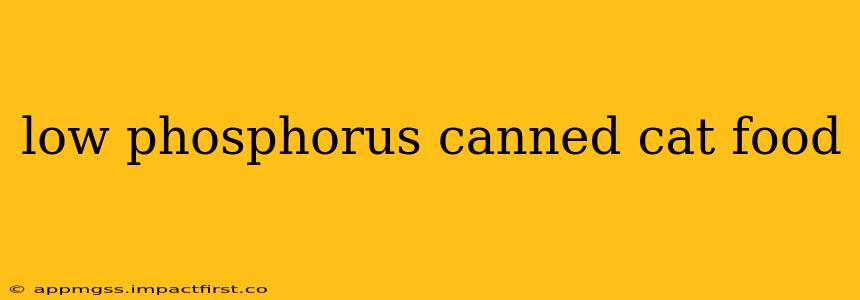Cats with kidney disease often require a diet low in phosphorus to help manage their condition and improve their quality of life. Choosing the right low-phosphorus canned cat food can be challenging, given the vast array of options available. This guide provides a comprehensive overview of low-phosphorus canned cat food, helping you make informed decisions for your feline companion's well-being.
What is Phosphorus and Why is it Important for Cats?
Phosphorus is an essential mineral vital for numerous bodily functions in cats, including bone health, energy production, and muscle function. However, cats with chronic kidney disease (CKD) often struggle to efficiently eliminate phosphorus from their bodies. This leads to a buildup of phosphorus in the blood (hyperphosphatemia), which can exacerbate kidney damage and worsen their condition. Therefore, managing phosphorus intake is crucial for cats with CKD.
Choosing the Right Low-Phosphorus Canned Cat Food: Key Considerations
Selecting the appropriate low-phosphorus canned cat food involves careful consideration of several factors:
-
Phosphorus Content: Look for food explicitly labeled as "low phosphorus" or "renal diet." The phosphorus content will typically be listed on the nutritional information panel. Aim for foods with the lowest phosphorus levels possible while still providing balanced nutrition.
-
Protein Content: High-quality protein is crucial for cats, especially those with CKD. While limiting phosphorus, ensure the chosen food provides sufficient protein to support muscle mass and overall health. Look for foods that list high-quality protein sources like chicken, turkey, or fish.
-
Other Nutrients: Ensure the food contains balanced levels of other essential nutrients like vitamins, minerals, and fatty acids, which are essential for overall health. Some renal diets are formulated to include specific nutrients to support kidney function.
-
Palatability: Cats can be picky eaters, especially when their health is compromised. Choose a food your cat enjoys to ensure adequate nutrient intake.
-
Veterinary Recommendation: Always consult your veterinarian before making significant dietary changes, especially for cats with pre-existing conditions. Your vet can assess your cat's individual needs and recommend the most appropriate low-phosphorus canned cat food.
What are the Different Types of Low-Phosphorus Canned Cat Food?
Many brands produce low-phosphorus canned cat food, often categorized as “renal” or “kidney” diets. These may vary in formulations, including ingredients, taste, and texture. Some options include pate, chunks in gravy, and flaked varieties. The best type depends on your cat's preferences and the recommendations from your veterinarian.
How Much Low Phosphorus Canned Cat Food Should I Feed My Cat?
The amount of food to feed your cat will depend on factors such as your cat's weight, age, activity level, and the specific recommendations provided by your veterinarian. Always follow the feeding guidelines on the food packaging as a starting point and adjust accordingly under veterinary guidance.
What are the Potential Side Effects of Low-Phosphorus Diets?
While generally safe, certain side effects may occur with low-phosphorus diets. These could include decreased appetite, weight loss, or digestive upset. It's essential to monitor your cat carefully and consult your veterinarian if any concerning issues arise. Always introduce the new food gradually to minimize digestive upset.
Can I Make My Own Low-Phosphorus Cat Food at Home?
While possible, creating a completely balanced low-phosphorus diet at home is challenging and generally not recommended without the guidance of a veterinary nutritionist. Homemade diets risk nutritional deficiencies if not properly formulated. Commercial low-phosphorus cat foods are formulated to meet your cat's needs.
Where Can I Buy Low-Phosphorus Canned Cat Food?
Low-phosphorus canned cat food is usually available at veterinary clinics, pet specialty stores, and online retailers. Your veterinarian can also advise on suitable options and help you source the food.
How Often Should I Check My Cat's Phosphorus Levels?
Regular blood tests to monitor phosphorus levels are crucial when managing CKD in cats. The frequency of these tests will be determined by your veterinarian based on your cat's condition and response to treatment.
This guide provides general information and should not replace advice from your veterinarian. Always consult your veterinarian for personalized recommendations concerning your cat's dietary needs, especially when dealing with conditions like CKD. Your vet can help you find the best low-phosphorus canned cat food to maintain your feline friend’s health and well-being.
